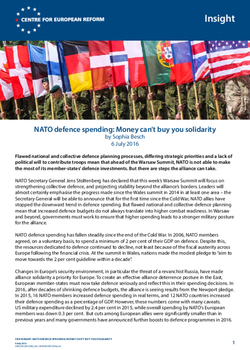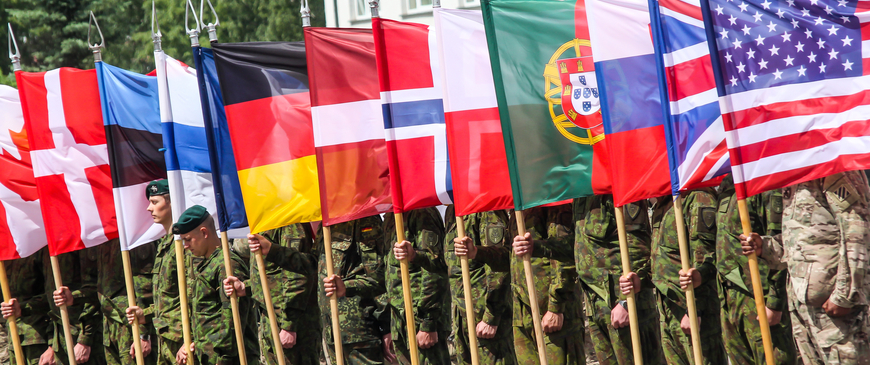
NATO defence spending: Money can't buy you solidarity
Flawed national and collective defence planning processes, differing strategic priorities and a lack of political will to contribute troops mean that ahead of the Warsaw Summit, NATO is not able to make the most of its member-states’ defence investments. But there are steps the alliance can take.
NATO Secretary General Jens Stoltenberg has declared that this week’s Warsaw Summit will focus on strengthening collective defence, and projecting stability beyond the alliance’s borders. Leaders will almost certainly emphasise the progress made since the Wales summit in 2014 in at least one area – the Secretary General will be able to announce that for the first time since the Cold War, NATO allies have stopped the downward trend in defence spending. But flawed national and collective defence planning mean that increased defence budgets do not always translate into higher combat readiness. In Warsaw and beyond, governments must work to ensure that higher spending leads to a stronger military posture for the alliance.
NATO defence spending has fallen steadily since the end of the Cold War. In 2006, NATO members agreed, on a voluntary basis, to spend a minimum of 2 per cent of their GDP on defence. Despite this, the resources dedicated to defence continued to decline, not least because of the fiscal austerity across Europe following the financial crisis. At the summit in Wales, nations made the modest pledge to “aim to move towards the 2 per cent guideline within a decade”.
Changes in Europe’s security environment, in particular the threat of a revanchist Russia, have made alliance solidarity a priority for Europe. To create an effective alliance deterrence posture in the East, European member-states must now take defence seriously and reflect this in their spending decisions. In 2016, after decades of shrinking defence budgets, the alliance is seeing results from the Newport pledge. In 2015, 16 NATO members increased defence spending in real terms, and 12 NATO countries increased their defence spending as a percentage of GDP. However, these numbers come with many caveats. US military expenditure declined by 2.4 per cent in 2015, while overall spending by NATO’s European members was down 0.3 per cent. But cuts among European allies were significantly smaller than in previous years and many governments have announced further boosts to defence programmes in 2016.
Increased defence spending means little unless translated into improved military capabilities #NATO
In Newport in 2014, NATO’s focus was on showing that all its members were committed to an effective and credible NATO. The 2 per cent target was designed to show that Europeans would pull their weight in providing for Europe’s defence, and thereby to persuade the United States to remain engaged on the continent.
Today, the United States still has every reason to push its European allies to spend more: in 2015, the US accounted for 50 per cent of NATO GDP and 72 per cent of its defence spending. Presumptive Republican presidential nominee Donald Trump recently complained that the United States was ‘getting ripped off by every country in NATO’, and while as president Hillary Clinton would probably be more diplomatic, her sentiment would be much the same.
Increased defence spending, however, means little unless it translates into improved military capabilities. As the CER has already written, since the end of the Cold War the West has become complacent about its military superiority. The combat readiness of European militaries is low; they lack sufficient numbers of troops and the right capabilities. The United Kingdom, one of only five NATO member-states that currently fulfil the 2 per cent pledge, has the highest number of deployable forces among EU NATO members. But in a recent report, a former NATO Supreme Allied Commander Europe (SACEUR) wrote that even the UK’s forces had been hollowed out to such an extent that the deployment of a brigade at a credible level of readiness would be a challenge. Similarly, in Germany, the third-largest military spender in Europe, a 2014 parliamentary inquiry found that much of its military equipment was unusable – only 24 of 56 Transall military transport aircraft were operational, just 42 of 109 Eurofighters and 38 of 89 Tornado fighter jets.
The German defence budget will increase by 6.2 per cent between 2015 and 2019 and the UK budget is set to rise in real terms every year until 2020 to meet the 2 per cent target. However, if the UK’s vote to leave the EU does indeed have the dire consequences forecast by the IMF, the GDP 2 per cent metric – if it can survive likely cuts to the budget – will mean less overall. And greater spending is not always accompanied by greater efficiency. Greece, which also meets the 2 per cent guideline, spends as much as 73 per cent of its defence budget on personnel costs, wages and pensions, and it is not alone.
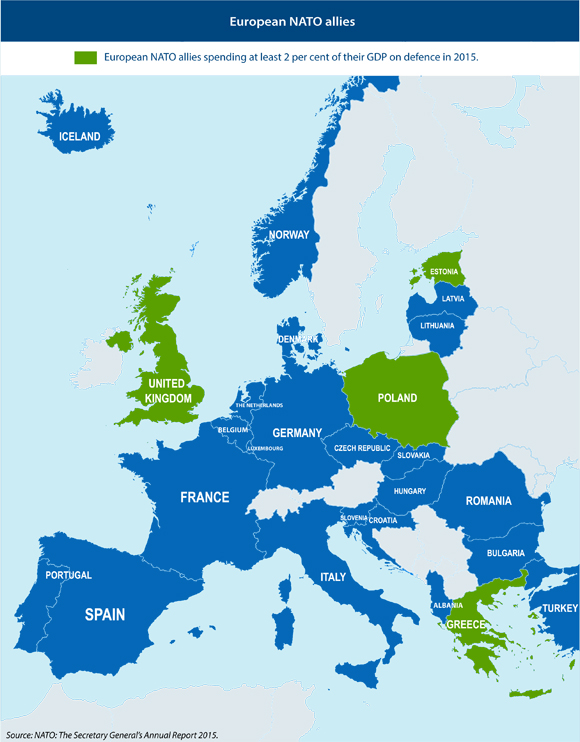
In an attempt to address the disconnect between defence spending and capability development, the Newport pledge commits allies to devoting 20 per cent of their defence expenditure to equipment and research and development (R&D). Military leaders tend to agree on the capabilities that the alliance needs. European members should focus in particular on developing independent military logistics and core capabilities such as long-range air transport, precision-guided munitions, and strategic intelligence and reconnaissance capabilities. The 2011 Libya operation showed that Europe also had a critical shortage of capabilities known as strategic enablers, like air-to-air refuelling and air and sea lift capabilities.
In 2015, 23 NATO countries did spend more on new equipment than they had in 2014. Eight allies met the NATO guideline, as compared to seven in 2014. But often, money spent on equipment does not benefit the alliance as a whole by as much as it could. Instead, national protectionism leads to unco-ordinated development of capabilities.
For reasons of national industrial policy and state-subsidised job-creation, many European governments buy from uncompetitive local firms. Because they steer contracts to national firms, many states produce only the equipment that they can afford, without paying much attention to the strategic needs of NATO. These protectionist policies lead to duplication and redundancy: the EU-28 alone maintain 37 types of tanks, 12 types of tanker aircraft and 19 types of combat aircraft.
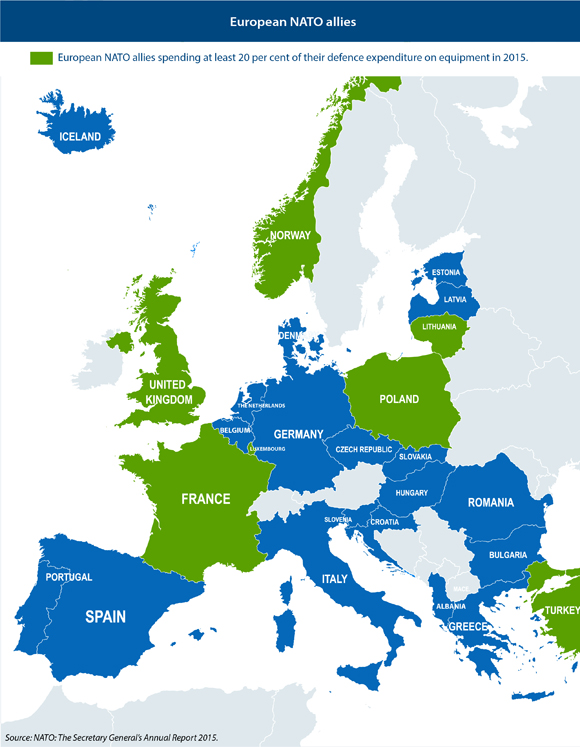
There is a clear need to rationalise; but this is a task that must involve not only NATO but the EU, in co-ordinated reforms of defence planning procedures. The EU’s new Global Strategy states that the union plans to deepen its partnership with NATO in defence capability development (among other things). NATO should make a similar commitment in Warsaw, where the EU and NATO plan to issue a joint statement on co-operation in a number of fields.
NATO defence planning is built around members reporting to the alliance. NATO’s political ambition is translated into a list of capability targets, which are then allocated to nations. On the EU side, the European Defence Agency (EDA) has a mandate to co-ordinate capability planning between national ministries of defence. Like NATO, it aims to get member-states to spend 20 per cent of their defence budgets on procurement and R&D.
NATO and the EDA bring different strengths to the table. NATO’s approach to defence planning has the potential to be more influential than that of the EDA, in that it sets targets for individual states, and they have to report back on their performance. The EDA only outlines collective priorities, without attempting to identify which EU member-states should fulfil them. The agency is better placed than NATO, however, to link capability planning with the strengthening of Europe’s defence technological and industrial base, an issue that is of great interest to the alliance. For example, the EDA can map capability requirements against industrial competences in member-states to identify areas in which clusters of countries can move forward together, rather than buying ‘off the shelf’ from a third country.
#NATO’s problem is that military tools are of limited relevance to most of the problems in the South
A NATO-EU working group dedicated to the exchange of views has been formed, but Turkey, which is not an EDA member, is currently blocking concrete co-operation. The CER has argued in the past that Turkey should join the agency: aligning EU and NATO efforts in defence planning would help to ensure that European governments – and NATO – get more for their money.
Rising defence budgets reflect the threat perception of individual member-states. Inevitably, strategic priorities differ depending on their location. In recent years, the security situation has worsened both in NATO’s eastern neighbourhood and at its southern border. Russia’s threatening posture was clearly behind the spike in defence spending in many NATO member-states in the East. Poland’s military budget reached 2.2 per cent of GDP in 2015 – an annual increase in real terms of 21.7 per cent. The Baltic States increased their military expenditure in real terms by 7.3 per cent (Estonia), 15.6 per cent (Latvia) and 31.9 per cent (Lithuania) – though only Estonia meets the 2 per cent target. France on the other hand is looking to the South. Paris reversed planned cuts to its defence spending in response to terrorist attacks in Europe. It conducts overseas military operations in the Central African Republic, in the Sahel, and against the Islamic State in Syria and Iraq – without NATO, though sometimes in bilateral partnership with the US.
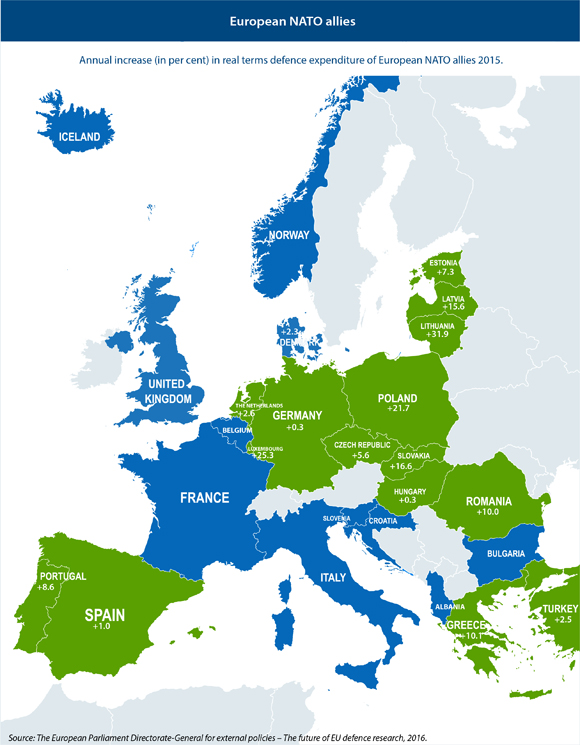
NATO has agreed on what to do in the East. But so far it lacks a coherent strategy to meet the security challenges in the South. Deploying troops is a reasonable response to the clearly defined territorial threat to the alliance’s eastern flank; but troops alone will do little to counter the violent extremism, failing states, and resultant migration flows destabilising the alliance’s southern border.
This divide has wider implications. Without a strategy for the South, NATO is conceding relevance and credibility in one of Europe’s most important trouble spots. NATO’s problem is that military tools are of limited relevance to most of the problems in the South. It could do more to help tackle the migration crisis by sharing intelligence and providing surveillance assets in the Mediterranean. But if southern European countries are to be persuaded to invest more in the defence capabilities that NATO needs in the East, the rest of NATO needs to show solidarity with the South by doing more to help relocate and resettle refugees, and to help the countries from which people migrate to Europe. This is more likely to be a task for the EU than for NATO. But both NATO and EU members should stop thinking about solidarity organisation by organisation. Allies, east and south, should no longer be allowed to ask for solidarity from NATO allies or EU partners without showing solidarity in return. For example, NATO member-states in the East that are asking for greater defence contributions from allies might extend an offer to resettle refugees through the EU in return.
At #WarsawSummit NATO shld call for a ‘contributions pledge’ to go along with the investment pledge
Finally, eastern member-states hoping for an increased NATO troop presence have learned that larger defence investments mean little if there is no political support to make troops available to the alliance. At the Warsaw summit, allies will announce the deployment of multinational battalions in each of the Baltic States and in Poland. Behind the scenes the alliance has struggled to convince European nations to contribute. The initial plan was for European nations to provide three of the battalions, but only Germany and the UK agreed. Reports suggest that Canada will take on the role of third lead nation in Warsaw – a quick fix, but unsatisfactory for those who are pushing for ‘freeriding’ European allies to invest more. The increase in defence spending after the Wales pledge has demonstrated the importance of political will in realising NATO targets. In Warsaw, the US and the Central Europeans should call for a ‘contributions pledge’, to go along with the investment pledge, committing member-states to make available forces at a credible level of readiness.
The willingness of NATO’s European allies to spend more on defence is good news. But the next step, in Warsaw and beyond, is for European leaders to turn higher spending into more and better equipment, and to contribute more troops able to use it.
Sophia Besch is a research fellow at the Centre for European Reform.

